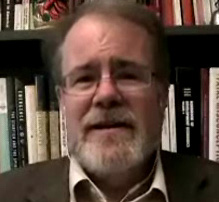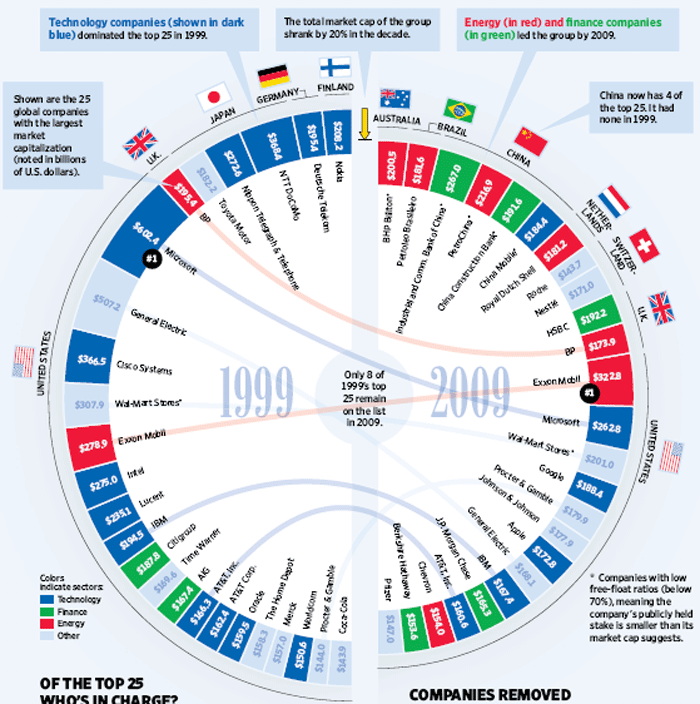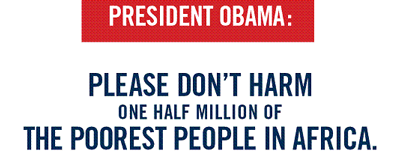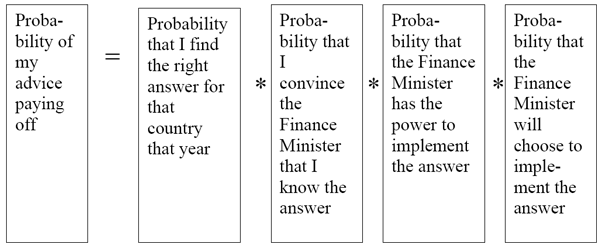Peter Singer and I on Tough Love for Our NGOs at NYT (the 6 minute video excerpt)
I am so grateful and humbled that my message on the accountability of aid has finally reached this extremely high profile -- wait, I just realized, there is NO audience, it's the holidays. For those of you who didn't have enough heavily spiked eggnog to listen to the whole 46 minute version, here is the New York Times' 6-minute excerpt of the conversation, emphasizing microcredit, evaluation, overhead costs, and the limits of generic "answers."
The audience gave us rave reviews (both of you) :
There is a superb Bloggingheads debate between Peter Singer (author of The Life You Can Save) and Bill Easterly (author of
I Hate Puppies and ChristmasThe White Man’s Burden). (Chris Blattman, what a card)Peter Singer and Bill Easterly on Bloggingheads.TV (Tyler Cowen, Marginal Revolution, "assorted link". OK this is not really a review but at least we made it into one of the hundreds of links Tyler chooses.)
I sense a juggernaut slowly (VERY slowly) building up toward that day when we demand results of our NGOs, of our official aid agencies, of our favorite celebrities, until we will all be able to join hands and say "Accountable at Last! Accountable at Last! Accountable at Last!"
Christmas Charity Gift-Giving Video Edition: Peter Singer and I on Bloggingheads.tv
 Today, the New York Times-sponsored Bloggingheads.TV put up a 45 minute video discussion {video link: Peter Singer & William Easterly on Bloggingheads.tv}, where Peter and I discuss imposing tough love on the global poverty charities who take your Christmas gifts and donations. I had given a critical review of Peter's latest book in the Wall Street Journal. Yet, Peter and I wound up agreeing that there is just as big a moral obligation on you to make sure your favorite charity gets the money to the poor, as much as there is for you to give the money in the first place. Let's see, if I follow Peter's logic correctly, I think that implies that you have a sacred moral & religous obligation, equivalent to rescuing a drowning child, to WATCH THIS VIDEO.
After a lot of criticism of NGO and offical aid lack of accountability and impressive fecklessness, including colorful insults and stories, we did get around eventually to making some positive recommendations on how you can give effectively, including specific charities (such as Women's Trust in Ghana) and monitoring web sites (such as the site Good Intentions are Not Enough).
Today, the New York Times-sponsored Bloggingheads.TV put up a 45 minute video discussion {video link: Peter Singer & William Easterly on Bloggingheads.tv}, where Peter and I discuss imposing tough love on the global poverty charities who take your Christmas gifts and donations. I had given a critical review of Peter's latest book in the Wall Street Journal. Yet, Peter and I wound up agreeing that there is just as big a moral obligation on you to make sure your favorite charity gets the money to the poor, as much as there is for you to give the money in the first place. Let's see, if I follow Peter's logic correctly, I think that implies that you have a sacred moral & religous obligation, equivalent to rescuing a drowning child, to WATCH THIS VIDEO.
After a lot of criticism of NGO and offical aid lack of accountability and impressive fecklessness, including colorful insults and stories, we did get around eventually to making some positive recommendations on how you can give effectively, including specific charities (such as Women's Trust in Ghana) and monitoring web sites (such as the site Good Intentions are Not Enough).
I hope this is not too much of a distraction, but I have to confess I really don't like talking to a camera, as will probably be apparent in this video (ouch). I love talking to real people in person, even 600 at a time, but talking to a machine is something that is still a work in progress for me. Maybe I should take lessons from one of the celebrity actors who work on aid -- now that is an area where they could use their skills productively!
Anyway, the message does come through loud and clear from both Peter and me: give, and, equally important, make sure your gifts reach the poor. Sounds so simple, and yet you have to work hard at the details to get it right.
Who knew that the aid organization most responsive to feedback is: the military?
I didn't see this one coming: that the nicest responses I have ever gotten to criticisms made on this blog came from military officers (both this time and on one previous occasion). I didn't know that a command-and-control ARMY would prove about 1 trillion times more responsive than the civilians at USAID. I didn't know that a Lieutenant General would handle criticism better than a Starbucks PR executivewho flamed out in response to another blog post (what DO they teach in PR school?) . OK, admittedly, the military hasn't changed anything yet that I know of, but at least they've engaged in a dialogue. Anyway I received this email from Lieutenant General William B. Caldwell IV in response to forwarding my mockery of the Powerpoint slides on nation-building in Afghanistan (also known as counter-insurgency or COIN):
Classification: UNCLASSIFIED Caveats: NONE
Bill:
do appreciate you passing this along to us in Kabul. Gave up command of the Combined Arms Center at Fort Leavenworth on 2 November and immediately deployed to Afghanistan. On 21 November assumed command here of the NATO Training Mission -- Afghanistan (which we activated at the same time) and Commanding General of CSTC-A. That said -- your blog hits home for all of us here.
Know that the ISAF team is looking at a variety of different products, including those you highlighted in your tweet. What I can tell you is that I have oversight and responsibility for our COIN Academy here and we are not using these slides in our instruction. There is a place for it among technical folks -- but not for the practitioner on the ground. Would be glad to share more about our Academy -- but suffice it to say, these are not our slides - and not how we teach COIN.
That said -- if anything, the slides reveal the sheer complexity of the problem we are all contending with -- at times so complex that it proves elusive to social mapping, as you can see. Do want you to know that those are only one of many items considered by the senior staff in their analysis, as we focus in on how best to proceed in our mission. Believe that as we leverage the best minds in this business -- of which you are a vital element -- the future prospects for Afghanistan will become brighter.
As an advocate for the practice, want you to know that your blogs are a welcome -- and refreshing -- presence. This is essential to our growth as an institution, and to our ability to learn. Your efforts are greatly appreciated, believe me.
Best to you and your family this holiday season. We have snow in Afghanistan, so at least we'll have a white Christmas here, although far from home and loved ones.
Best -- Bill
What exactly is “Climate Aid”?
Alan Beattie has a great piece on this murky concept in the FT. Here is Alan’s exposition recast in the form of Q and A: Q: Should “climate aid” be additional to existing aid?
A: Of course, except how do you define “existing aid”? Should the yet-to-be-fulfilled climate aid pledges be added to the yet-to-be-fulfilled pledges for general aid made in Gleneagles in 2005? Or should they just be added to the actual current disbursements of aid, so you could substitute less generous climate pledges for more generous Gleneagles pledges?
Q: How to guarantee that “climate aid” is spent on climate?
A: Aid veterans have long known this horrible jargon “fungibility.” What this means is that the recipients of climate aid may cut back their own spending on climate-related areas to be replaced by “climate aid”, and increase their own spending on something else. So the real effect of “climate aid” is really to increase something else. As the World Bank’s first chief economist said way back in 1953: “you might think you are financing a power plant and you are really financing a brothel.”
Q: By the way, what IS Climate Aid anyway?
A: Let’s answer this with another question: if you have a project for solar pumps to irrigate farms to grow crops for export, is this (a) climate aid, (b) agriculture aid, or (c) aid for trade? Does the answer depend on which type of aid is currently most popular?
We count our holiday blessings in development
This post is NOT a satire. Aid Watch has a previously-unsuspected sentimental streak and wants to embrace the holiday tradition of counting your blessings. Our best holiday wishes: (1) To our readers and commentators, the smartest, most field-smart, sexiest group in the blogosphere
(2) for ALL the people who work so hard around the world under difficult conditions (which includes getting grief from aid critics) trying to reduce poverty, disease, and illiteracy
(3) For the growing number of African intellectuals and activists standing up to the aid agencies and campaigning for democracy and self-determination for Africans
(4) For “the poor” themselves, who ignore labels such as “the poor,” and in this generation, have already achieved the greatest escape from poverty in human history
Where was the person in the room who laughed out loud?



We now have the full Pentagon nation-building plan for Afghanistan that led up to the slide featured in an earlier post . (hat tip to Chris Coyne). The slides are credited to PA Consulting Group, a leading London-based firm whose motto is "Questions. Answered." A possibly relevant line in their self-description is that they "supported the delivery of multibillion-dollar defence projects."
The terror and triumph of free markets
 The Wall Street Journal featured this awesome chart yesterday. Only 8 of top global 25 companies in 1999 are still in top 25 in 2009, and some of them have shed a lot of market cap.
One reaction is that free markets are very scary if you were an employee or shareholder of one of the 1999 companies that crashed. OK this kind of destruction scares ALL of us.
The Wall Street Journal featured this awesome chart yesterday. Only 8 of top global 25 companies in 1999 are still in top 25 in 2009, and some of them have shed a lot of market cap.
One reaction is that free markets are very scary if you were an employee or shareholder of one of the 1999 companies that crashed. OK this kind of destruction scares ALL of us.
Another reaction is that creative destruction is one of the triumphs of the market. The consumer is king: in 2009, the consumer wants iPhones in their Xmas stocking and not whatever Worldcom had been pretending to be producing. The radical uncertainty of how to please consumers is an argument FOR free markets:
It is because every individual knows so little and… because we rarely know which of us knows best that we trust the independent and competitive efforts of many to induce the emergence of what we shall want when we see it. (Friedrich Hayek)
Levi’s urges youth to conquer Native Americans again
 Levi’s has a new ad campaign that suggests American liberty is still a work in progress. One of its new videos has a voiceover reciting the Walt Whitman poem “O Pioneers” with youths dancing around a fire wearing Levi’s. [Watch video here: Levi\'s Commercial.] The recitation includes lines like
Levi’s has a new ad campaign that suggests American liberty is still a work in progress. One of its new videos has a voiceover reciting the Walt Whitman poem “O Pioneers” with youths dancing around a fire wearing Levi’s. [Watch video here: Levi\'s Commercial.] The recitation includes lines like
get your weapons ready; Have you your pistols? … We, the youthful sinewy races, all the rest on us depend… Fresh and strong the world we seize
Against whom are our weapons supposed to be used? Whose world are we seizing? Any 3rd grader could tell you: Whitman is referring to the war against Native Americans by westward-bound settlers and the US army.
Does Levi’s want to celebrate that? Well, try to see it from Levi’s point of view: their company wouldn’t even exist if we hadn’t wiped out the Indians.
OK, trying to be a little more serious, Levi’s running this ad shows how we still don’t take seriously enough our Euro-American historical crimes. I know many people are tired of this topic. This is also a constant bone of contention between the Left and the Right, with the Right blaming the Left for apologizing too much and overlooking the great accomplishments of Western Civilization, like Individual Rights.
There is a middle ground: those of us of Euro-American heritage would be a lot more convincing on Individual Rights by acknowledging that we have had as much trouble applying them as anybody else. We were pioneers in applying them to our own ethnic group, but we kept handing out free passes to kill other people's rights.
So no more holier-than-thou preaching about individual rights. At least, we have made progress on eroding some Double Standards: Jew and Gentile, White and Black, Man and Woman. Probably the worst Double Standard left is between rich and poor societies – we believe in Democracy in the former but not in the latter. So let’s acknowledge how hard it has been, but keep striving for Liberty for All.
Aid Watch holiday break
Aid Watch is officially on holiday break from December 20 to January 4. We will occasionally put up posts when the strenuous holiday schedule allows. There is some danger that any such posts will be even more offbeat than usual. Happy Holidays to our wonderful readers, commentators, and guest bloggers!
Copenhagen Post-Mortem: Global Summit Realism
Sorry to give the bad news evidence, but just think: for several decades, we have had tons of international summits
almost all of them have failed to produce anything of value
Why do we keep setting our expectations so high?
Maybe we should try some other path of change besides the Big International Summit?
Arvind Subramanian replies to his (and our) critics
Today, David Roodman at the Center for Global Development responded to our guest blogger Arvind Subramanian's post (and forthcoming paper) on the effects of aid on manufacturing exports. Here, Arvind replies:
I cannot think of a more thoughtful follower of, and contributor to, the aid effectiveness literature than David Roodman (Aart Kraay is another). So, I am really very pleased with his bottom line assessment of my paper that he trusts this paper “more than most” in the aid growth literature.
That said, there is one point about his blog that merits a response. David gently chides Bill Easterly for his tweet where Bill interprets and presents our paper as showing that aid is bad for manufacturing exports. David’s point is that our paper strictly speaking only establishes a relative effect—that exportable sectors grow slower than non-exportable sectors —and not a total or overall effect: that aid leads to slower growth in exports as a whole.
But two points are worth noting. In a longer version of the paper, that I will post on my web-page, we do find evidence that aid leads to slower growth of the manufacturing sector as a whole. For methodological reasons, this result is less strong than our core result about relative effects. But, we certainly don’t get the empirical result that aid raises growth in all sectors that David claims (rightly) is theoretically possible.
Perhaps more important, Bill’s tweet does capture the spirit of our paper. Whether and how manufacturing exports can be an engine of overall growth is still debated. But the historical experience is strongly suggestive that if export sectors grow slowly or grow slower than other sectors, overall growth is affected. So, our paper could be interpreted not as a lament about the effects of aid on export sectors but as a celebration of its effects on non-export sectors. But, in my view and also in the historical record, between export and non-export sectors as an engine of growth, there is no contest.
Madagascar textile workers ask President Obama to keep their jobs for Christmas, but nobody is listening
Here's an excerpt from an ad that appeared in the print edition of Politico today, paid for by the owners of apparel factories in Madagascar and one of their American investor partners. We have blogged about this seemingly obscure issue already many more times than you, our patient readers, may have wanted, but we see this as one of those rare, clear opportunities for the US to do good by first doing no harm. And yet US leadership seems blithely set on a course of action that will punish vulnerable textile workers and their families without touching the fortunes of the political elite responsible for Madagascar's current predicament.

President Obama: Please don’t harm one half million of the poorest people in Africa.
Your advisors have recommended that you decertify Madagascar as a beneficiary country for benefits under the Africa Growth and Opportunity Act (AGOA). This action will revoke the duty free treatment for products such as trousers, t-shirts and sweaters produced in Madagascar next year—re-imposing steep US import taxes as high as 32% on a polyester t-shirt. This action will make garments produced in Madagascar uncompetitive with similar products made in China — which already produces 100 times more apparel for the US market compared to Madagascar.
We ask you to consider the human tragedy of an action that will wipe out 100,000 good jobs in the Madagascar apparel sector created under AGOA. Surely there is a way to send a strong message to feuding politicians in Madagascar — without punishing innocent workers and their families who have nothing to do with the disputed control of Government. Your advisors will tell you that they are doing this to help people in Africa.
We respectfully disagree.
While we hope that the continued destabilized situation in the Government of Madagascar is hopefully only temporary, we know that the exit that results from AGOA decertification from the country of our American retail customers will be permanent.
Over 28,000 of our employees signed a petition to President Obama asking him to save their jobs. A copy of that letter can be viewed at www.gefp.com.
The effects of foreign aid: Dutch Disease
This blog post was written by Arvind Subramanian, Senior Fellow at the Peterson Institute for International Economics and Center for Global Development, and Senior Research Professor at Johns Hopkins University.
The voluminous literature on the effects of foreign aid on growth has generated little evidence that aid has any positive effect on growth. This seems to be true regardless of whether we focus on different types of aid (social versus economic), different types of donors, different timing for the impact of aid, or different types of borrowers (see here for details). But the absence of evidence is not evidence of absence. Perhaps we are just missing something important or are not doing the research correctly.
One way to ascertain whether absence of evidence is evidence of absence is to go beyond the aggregate effect from aid to growth and look for the channels of transmission. If we can find positive channels (for example, aid helps increase public and private investment), then the “absence of evidence” conclusion needs to be taken seriously. On the other hand, if we can find negative channels (for example, aid stymies domestic institutional development), the case for the “evidence of absence” becomes stronger.
One such channel is the impact of aid on manufacturing exports. Manufacturing exports has been the predominant mode for escape from underdevelopment for many developing countries, especially in Asia. So, what aid does to manufacturing exports can be one key piece of the puzzle in understanding the aggregate effect of aid.
In this paper forthcoming in the Journal of Development Economics, Raghuram Rajan and I show that aid tends to depress the growth of exportable goods. This will not be the last word on the subject because the methodology in this paper, as in much of the aid literature, could be improved.
But the innovation in this paper is not to look at the variation in the data across countries (which is what almost the entire aid literature does) but at the variation within countries across sectors. We categorize goods by how exportable they could be for low-income countries, and find that in countries that receive more aid, more exportable sectors grow substantially more slowly than less exportable ones. The numbers suggest that in countries that receive additional aid of 1 percent of GDP, exportable sectors grow more slowly by 0.5 percent per year (and clothing and footwear sectors that are particularly exportable in low-income countries grow slower by 1 percent per year).
We also provide suggestive evidence that the channel through which this effect is felt is the exchange rate. In other words, aid tends to make a country less competitive (reflected in an overvalued exchange rate) which in turn depresses the prospects of the more exportable sectors. In the jargon, this is the famous “Dutch Disease” effect of aid.
Our research suggests that one important dimension that donors and recipients should be mindful of (among many others that Bill Easterly has focused on) is the impact on the aid-receiving country’s competitiveness and export capability. That vital channel for long run growth should not be impaired by foreign aid.
Is “Delivering as One” failing to deliver? The case for a market-based approach to UN reform
The following post is co-written by Sandra Sequeira, Professor of Development Economics at the London School of Economics and visiting scholar at DRI, and Christian Schornich, who works for the United Nations. The proportion of aid channeled through the UN system shrank from ten percent to five percent over the last eight years. And yet the UN’s massive bureaucratic machinery is not being downsized accordingly. In fact, a complicated web of programs and agencies with a whopping 7,000 overlapping mandates—sometimes even working at cross-purposes— have in recent decades defied numerous bouts of reform.
Three years ago, the UN launched a new initiative entitled “Delivering as One,” meaning that in each country there would be one leader coordinating all agencies in the field, one budgetary framework, and one operational support system. The goal was to increase efficiency, cut waste and pass on administrative savings to programs. Eight countries from Mozambique to Cape Verde volunteered to pioneer this reform. While cutting the fat out of the UN system is a commendable goal, a deeper issue failed to make it to the discussion table: should reform only represent a centripetal force towards becoming one, or a centrifugal force that propels multiple agencies to compete in the market for aid and justify their relevance?
Since the beginning of “Delivering as One,” no departments have been merged and not a single program has been cut. Three years into the process, administrative savings are yet to be calculated because there is no budgetary framework that clearly accounts for the overhead costs of the different agencies and programs.
There is a real danger that the search for “Oneness” has already become just another episode in a series of floundering reforms, where “harmonization” and “integration” really mean covering up inefficiencies and keeping underperforming agencies and programs afloat. But here’s an alternative: the UN could seize the opportunity to rethink its mandate based on its comparative advantage in the current market for aid, and stick to it.
What would happen if the UN stopped thinking of itself as a world government in the business of only providing public goods, where cost-effectiveness is not necessarily the bottom line, and started thinking of itself as an organization actively competing with other agencies in the market for aid? The landscape of aid agencies has changed dramatically since 1945—the UN is now forced to compete against McKinsey when providing technical support to Latin American governments, with the Gates Foundation when fighting HIV/AIDS in Africa, and with the US military when building schools in the foothills of Afghanistan.
The aid market is segmented by fields, and competition varies significantly across them. There are "natural monopolies" which require agencies like the UNHCR to secure the rights and well-being of refugees across political borders, UNRWA, the International Atomic Energy Agency, the International Court of Justice or the WTO. In these fields, a UN monopoly is justified by the high political and fixed costs of setting up an inter-governmental cooperation mechanism, by decreasing marginal costs of providing the service, and by positive network effects.
Other agencies like the United Nations Industrial Development Organization (UNIDO) and the United Nations Development Program (UNDP) operate in highly competitive markets. In more extreme cases, the UN even competes against itself via the International Fund for Agricultural Development (IFAD), the Food and Agriculture Organization (FAO) and the World Food Program (WFP); the United Nations Development Fund for Women (UNIFEM), the Joint United Nations Program on AIDS (UNAIDS), and the United Nations Population Fund (UNFPA); the United Nations Conference on Trade and Development (UNCTAD) and the International Trade Center (ITC), among others.
The UN's search for comparative advantage could be compared to a government deciding which services to provide directly and which services to privatize. Areas in which the benefits of competition can be high through the creation of incentives to deliver high-quality services at the lowest cost possible are prime fields for “privatization.” In these segments of the market for aid, the UN could act as the "aider of last resort" instead of a frontline participant. This would mean specializing in areas in which there is a clear need for large-scale interventions, but where no private corporations, NGOs, civil society or development consulting agencies dare to go. While this would be the path less traveled, it may be the only one that leads to meaningful reform.
Fundamental Lunch-Napkin Equation Valuing Development Expertise
I had a lunch with my boss a long,long time ago at the World Bank Research Department to discuss my research. He listened impatiently to my description of my various research papers and finally burst out, “yes, but what would you tell the Finance Minister to do tomorrow?” I got asked this question what seemed like thousands of times while I was at the Bank. It’s still at the heart of the Bank’s approach to development today, shared by many others. It is fairly simple to calculate the following:[1]

All these probabilities are likely to be low. Multiplied together, the overall probability of my advice paying off is pathetically, infinitesimally low.
If my boss forced me to answer me that question, today I would say to the Finance Minister: “Disregard us World Bank experts. You already know that principles of economics help solve economic problems. You already know you should be democratically accountable to your own citizens. You’ll muddle through.”
I didn’t yet have the courage or wisdom to give that answer at that lunch long ago, so my Bank research department career lasted a while longer after that.
[1] This equation is partly inspired by a different equation that Pete Klenow suggested for the value of economics research in the Brookings volume “What Works in Development: Thinking Big and Thinking Small”
Aid Watch Grinch Edition: Are We Mean to Ask that NGO Ads not be Simplistic and Wrong?
In the spirit of the holidays, let's ponder the strategy of using forlorn children and their bellies for fund-raising, which seems to intensify each year around this time.
I was introduced to Skip1.org, a new marketing effort of the Children’s Hunger Fund by a friend over Thanksgiving dinner. I was pulled in by the simple message “Skip something. Feed a child.”
To illustrate this, the site has a video of plates of gourmet steak and veggies being transported from a table at an upscale restaurant to starving children in another country – still on their pristine white plates, served by a smiling waitress. If this bore any relationship to what CHF actually did, Aid Watch could evaluate the number of children served, how their parents were involved, whether these children grew up to grow their own food, the effectiveness of serving children on white china, etc.
Of course, aid veterans, although not the general public, know that direct donor-to-child transfers never happen because of high transaction costs, so the ad is already misleading in a very well known way. But then we find out that the reality is that CHF is not even primarily a food distributor. According to their website, they do send “Food Paks” around the world to needy families, not just children. The photo of a Food Pak features an American diet, including saltine crackers and animal crackers, intended to feed entire families.
However, according to Fred Martin, Communications Director at CHF, “In fact our Food Pak program is a small portion of what we do. We highlight it because it is our flagship program that we’ve seen work very well in building relationships with the poor so that deeper needs can be uncovered and responded to.” I learned from Fred they also provide beds in eastern Europe and medicines in Asia, which are not identified on their website or their annual report to donors (only the totals of aid given by country or region). By reviewing their financials (IRS form 990), one sees of the extent of their non-food work: 85 percent of their donations are, in fact, medical supplies and medicines; they also collect and distribute toys, bicycles, beds and millions of dollars of clothing (a form of aid that NGO critics like Good Intentions are Not Enough is critical of).
I believe in helping people with supplies that make a difference, so, why do I sound like a Grinch? Because I believe in honesty in conveying what a charity really does. This ad seems to take us back to the simplistic and wildly inaccurate Sally Struthers “save a child” world, long since discredited. Can we please hang onto progress in aid transparency when we make some?
Tiger Woods thoughtfully explodes “Halo Effect” myth in development (editorial note)
For anyone who noticed or got confused by Google Reader: A preliminary draft of the Tiger Woods post accidentally went live at midnight on Saturday night. We took it down again on early Sunday morning, and the absolutely correct analysis of Tiger Woods was re-posted early this morning, taking into account any late-breaking news on this major world news story.
Tiger Woods thoughtfully explodes “Halo Effect” myth in development
I am sure all of you had the same reaction I did as Tiger Woods slid into taudry tabloid hell: “thanks, Tiger, for creating a teachable moment for development economics!” Our expectation that celebrities will be model citizens, contrary to vast evidence, is based on the Halo Effect. The Halo Effect is the idea that someone that is really, really good at one thing will also be really good at other things. We thought because Tiger was so good at being a golfer, he also must be very good at to have and to hold, forsaking all others, keeping thee only unto her as long as you both shall live…
What Tiger considerately did for our education was to show how the Halo Effect is a myth. This blog has a undying affection for those psychological foibles that cause us to strongly believe in mythical things, and the Halo Effect is a prime example (and the subject of a whole book on its destructive effects in business.) Why would marital fidelity and skillful putting have any correlation?
OK fine and good, but many of you are asking: What the Vegas Cocktail Waitress does this have to do with development? The Halo Effect was discussed in a previous blog, but when assaulting psychological biases, you can never repeat the attack enough. Not to mention that we all remember the psychology literature more easily when illustrated by a guy with 10 mistresses.
So if we observe a country is good at say, technological innovation, we assume that this country is also good at other good things like, say, visionary leadership, freedom from corruption, and a culture of trust. Since the latter three are imprecise to measure (and the measures themselves may be contaminated by the Halo Effect), we lazily assume they are all good. But actually, there are plenty of examples of successful innovators with mediocre leaders, corruption, and distrustful populations. The US assumed world technological leadership in the late 19th century with presidents named Chester Arthur and Rutherford B. Hayes, amidst legendary post-Civil War graft. Innovators include both trusting Danes and suspicious Frenchmen.
The false Halo Effect makes us think we understand development more than we really do, when we think all good things go together in the "good" outcomes. The "Halo Effect" puts heavy weight on some explanations like "visionary leadership" that may be spurious. More subtly, it leaves out the more complicated cases of UNEVEN determinants of success: why is New York City the world’s premier city, when we can’t even manage decent airports (with 3 separate failed tries)?
The idea that EVERYTHING is a necessary condition for development is too facile. The principles of specialization and comparative advantage suggest you DON"T have to be good at everything all the time.
So the true Tiger Woods Effect tells us something else more interesting than the false Halo Effect: that if you are very, very good at hitting a 1.68 inch ball into a 4.25 inch hole, then you can often get away with everything else for a long time. But sometimes not forever.
“What works in development?” Apparently not markets for books on “What works in development”
A previous blog highlighted the book Jessica Cohen and I edited "What works in development" (self-promotion disclaimer: I was just an organizer; the attractions were stellar academics heatedly debating the pros and cons of Randomized Experiments in development). We got a nice response from readers (the blog post was the 2nd most popular on Aid Watch since we launched the new site October 14th), and many seemed to want the book. However, for markets to work, we need not only demanders but also rational suppliers. Here something has gone wrong, not quite sure what. After the book jumped up the ranks at Amazon and Barnes & Noble, it sold out at both sites and is indefinitely out of stock.
As for the enigmatic publisher, Brookings Institution Press, finding the book on its web site is a bit of a challenge. It is not in the “New Releases” section, which has 6 books published in 2008. It is not in the section on “Poverty and Development. ” You would have more luck looking at the Brookings Global Economy and Development Program website, which features the book, but that requires a bit of inside knowledge.
To save you endless searching, I spent half the day tracking it down for you. The Brookings link is here. Maybe this will help Amazon find the book from Brookings as well.
Sorry for whining, but when you have worked hard at facilitating something that the customers seem to want, it’s a bit frustrating to having recalcitrant suppliers get in the way.
After all this, you can actually order the book online from the Brookings Institution Press, allowing for 1 to 2 weeks delivery. Otherwise, you could get Sarah Palin’s insights on What Works from Amazon, delivered tomorrow.
 From Aid to Equality
From Aid to Equality


